| Srl | Item |
| 1 |
ID:
123729
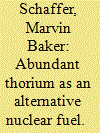

|
|
|
|
|
| Publication |
2013.
|
| Summary/Abstract |
It has long been known that thorium-232 is a fertile radioactive material that can produce energy in nuclear reactors for conversion to electricity. Thorium-232 is well suited to a variety of reactor types including molten fluoride salt designs, heavy water CANDU configurations, and helium-cooled TRISO-fueled systems.
Among contentious commercial nuclear power issues are the questions of what to do with long-lived radioactive waste and how to minimize weapon proliferation dangers. The substitution of thorium for uranium as fuel in nuclear reactors has significant potential for minimizing both problems.
Thorium is three times more abundant in nature than uranium. Whereas uranium has to be imported, there is enough thorium in the United States alone to provide adequate grid power for many centuries. A well-designed thorium reactor could produce electricity less expensively than a next-generation coal-fired plant or a current-generation uranium-fueled nuclear reactor. Importantly, thorium reactors produce substantially less long-lived radioactive waste than uranium reactors.
Thorium-fueled reactors with molten salt configurations and very high temperature thorium-based TRISO-fueled reactors are both recommended for priority Generation IV funding in the 2030 time frame.
|
|
|
|
|
|
|
|
|
|
|
|
|
|
|
|
| 2 |
ID:
062818


|
|
|
| 3 |
ID:
103520
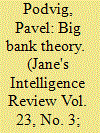

|
|
|
| 4 |
ID:
132610
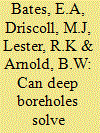

|
|
|
|
|
| Publication |
2014.
|
| Summary/Abstract |
The United States is in need of a new and more adaptive long-term strategy for spent nuclear fuel. In this communication, we outline the fundamental reasons why deep borehole disposal should receive more detailed investigation, alongside traditional shallow mined repositories. This potential solution is supported by advancing drilling technologies and an improving understanding of extremely long fluid residence times in deep bedrock. Radionuclide isolation is supported by verifiable and stable geologic barriers such as long transport distances to aquifers, low permeability, and reducing chemical conditions. The modular nature of implementing deep borehole disposal could offer unique programmatic and economic advantages. Experience with a pilot borehole program will be required to confirm the feasibility of drilling and emplacement operations, and key chemical and hydraulic conditions.
|
|
|
|
|
|
|
|
|
|
|
|
|
|
|
|
| 5 |
ID:
082845


|
|
|
|
|
| Publication |
2008.
|
| Summary/Abstract |
The Nuclear Problem: Hopes and Disappointments ... The main achievement of 2007 in the solution of the nuclear problem on the Korean Peninsula, judging by the words of the participants in the six-party negotiations on the subject, as well as most experts, was the freezing and, some time later, the decommissioning of the main objects of the plutonium nuclear program of the DPRK - the gas-graphite reactor of 5-megawatt capacity and two enterprises: the first often called a radiochemical laboratory, which processed spent fuel, and another which produced fresh nuclear fuel. ...
|
|
|
|
|
|
|
|
|
|
|
|
|
|
|
|
| 6 |
ID:
000959
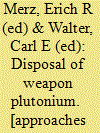

|
|
|
|
|
| Publication |
Dordrecht, Kluwer academic publishers, 1996.
|
| Description |
xx, 339p.
|
| Standard Number |
0792338413
|
|
|
|
|
|
|
|
|
|
|
|
Copies: C:1/I:0,R:0,Q:0
Circulation
| Accession# | Call# | Current Location | Status | Policy | Location |
| 038684 | 338.4762148335/MER 038684 | Main | On Shelf | General | |
|
|
|
|
| 7 |
ID:
107725
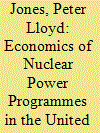

|
|
|
|
|
| Publication |
London, macmillan Press, 1984.
|
| Description |
xix, 168p.Hbk
|
| Standard Number |
0333350952
|
|
|
|
|
|
|
|
|
|
|
|
Copies: C:1/I:0,R:0,Q:0
Circulation
| Accession# | Call# | Current Location | Status | Policy | Location |
| 027518 | 621.483/JON 027518 | Main | On Shelf | General | |
|
|
|
|
| 8 |
ID:
077378
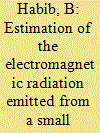

|
|
|
|
|
| Publication |
2007.
|
| Summary/Abstract |
Centrifuges used to enrich uranium utilize an electric motor to spin the rotors to high speeds. The current flowing in these motors emits electromagnetic radiation. This article presents a model that estimates the strength of the radiation as a function of distance from the centrifuge plant. It discusses the dependence of the radiative power on the size of the plant, the noise sources at the frequencies at which the motors operate, and means of detecting the signal from a centrifuge enrichment facility. According to the findings, a plant running 1,000 P-2 type centrifuges emits electromagnetic radiation that should be detectable in a 0.5-3 kilometer range in the absence of shielding.
|
|
|
|
|
|
|
|
|
|
|
|
|
|
|
|
| 9 |
ID:
052204
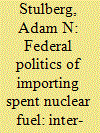

|
|
|
| 10 |
ID:
062705
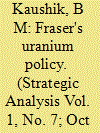

|
|
|
| 11 |
ID:
021677
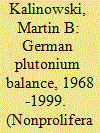

|
|
|
|
|
| Publication |
Spring 2002.
|
| Description |
146-160
|
|
|
|
|
|
|
|
|
|
|
|
|
|
|
|
| 12 |
ID:
067765
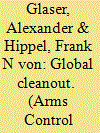

|
|
|
| 13 |
ID:
099644
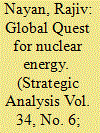

|
|
|
| 14 |
ID:
021125
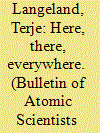

|
|
|
|
|
| Publication |
Nov-Dec 2001.
|
| Description |
57-64
|
|
|
|
|
|
|
|
|
|
|
|
|
|
|
|
| 15 |
ID:
082429
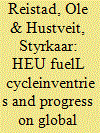

|
|
|
|
|
| Publication |
2008.
|
| Summary/Abstract |
In 2007, 334 nuclear reactors (including for naval propulsion) and isotope production facilities employed highly enriched uranium (HEU) fuel or target material. One year of operations at these reactors and facilities required more than 3,100 kilograms (kg) of HEU for naval propulsion, more than 750 kg for research reactors, and 40?-50 kg for isotope production in civilian facilities-in addition to several tons used in other types of reactors. Material with high enrichment levels and low radiation barriers stored or handled in large batches, such as HEU target waste and certain types of fuel from isotope production, research reactors/critical assemblies, and naval fuel, presents serious safety and security concerns. Forty-eight civilian research reactors have converted to low-enriched uranium as a result of a three-decade international effort to minimize HEU use, resulting in a decrease in HEU consumption of 278 kg per year. This article's establishment of baseline measurements for assessing the results of HEU minimization efforts calls for additional focus on the scope and methodology of HEU minimization. Facility decommissioning and dismantling should play a larger role in the future HEU minimization effort, materials with specific weapons-relevant properties should be given higher priority compared to bulk HEU material, and the use of large quantities of weapon-grade HEU fuel for naval propulsion should be reconsidered.
|
|
|
|
|
|
|
|
|
|
|
|
|
|
|
|
| 16 |
ID:
134084
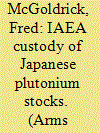

|
|
|
|
|
| Publication |
2014.
|
| Summary/Abstract |
Even before the 2011 Fukushima nuclear disaster shut down all 48 Japanese nuclear reactors, Japan's plan to reprocess its spent nuclear fuel and use the recovered plutonium and uranium as mixed-oxide (MOX) fuel in its nuclear power plants suffered from significant delays.
|
|
|
|
|
|
|
|
|
|
|
|
|
|
|
|
| 17 |
ID:
117532
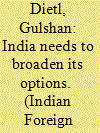

|
|
|
| 18 |
ID:
099514
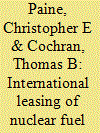

|
|
|
|
|
| Publication |
2010.
|
| Summary/Abstract |
Current International Atomic Energy Agency safeguards do not provide adequate protection against the diversion to military use of materials or technology from certain types of sensitive nuclear fuel cycle facilities. In view of highly enriched uranium's relatively greater ease of use as a nuclear explosive material than plutonium and the significant diseconomies of commercial spent fuel reprocessing, this article focuses on the need for improved international controls over uranium enrichment facilities as the proximate justification for creation of an International Nuclear Fuel Cycle Association (INFCA). In principle, the proposal is equally applicable to alleviating the proliferation concerns provoked by nuclear fuel reprocessing plants and other sensitive nuclear fuel cycle facilities. The INFCA would provide significantly increased nonproliferation assurance to its member states and the wider international community by holding long-term leasehold contracts to operate secure restricted zones containing such sensitive nuclear facilities.
|
|
|
|
|
|
|
|
|
|
|
|
|
|
|
|
| 19 |
ID:
065420
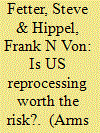

|
|
|
| 20 |
ID:
087891
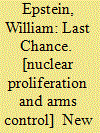

|
|
|
|
|
| Publication |
New York, Free Press, 1976.
|
| Description |
341p.
|
|
|
|
|
|
|
|
|
|
|
|
Copies: C:1/I:0,R:0,Q:0
Circulation
| Accession# | Call# | Current Location | Status | Policy | Location |
| 016098 | 341.734/EPS 016098 | Main | On Shelf | General | |
|
|
|
|